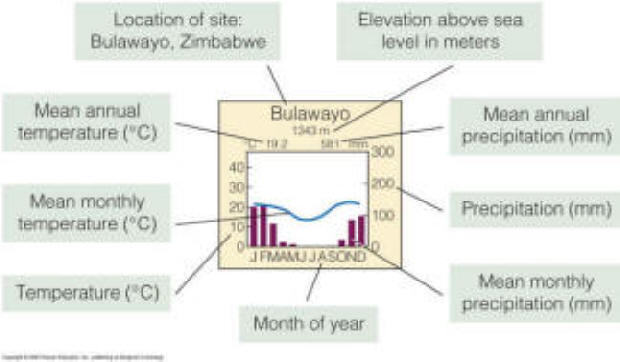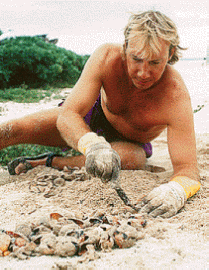Fundamentals of Ecology Class
Meetings
February 2013


Physiological Ecology
Announcements:
-
Homework for next Tuesday:
- read Willette et al. turtle article, & bring a copy to
class! (in O: drive, Readings folder)
- be able to address all the questions
related to the article (outlined below, as well as on
homework page)
- COME PREPARED to discuss the article in
class on Tuesday!!!
Thursday 2/21-
Outline of Main Objectives:
- Adaptations
- Physiology
- Constraints
Question 1: What do we mean by
"adaptations?"
-
Natural Selection
-
variation
(what are the sources of variation - how do they arise in a
population?)
-
heritability of the trait
-
differential
survival & reproduction (what do we call this?)
"hvf"
- what are some examples of ways
organisms can adapt to their environment?
Physiology - Biology of individual
organisms; study of individual function
Physiological Ecology -
Performance of individuals within the constraints of the abiotic
environment (e.g., what kinds of factors might form such constraints?).
... in other words, adaptations to the environment, at the
physiological level!
Question 2: The African Baobab

- Study area: Tsavo National Park,
Kenya
- Climate:
-

- What Biome do you think Tsavo
occupies?
- What plant growth forms should
dominate in this habitat?
- Details of Tsavo's climate -
- semi-arid
- scarce water & seasonal
precipitation
- punctuated by multi-year
droughts
- Specific Baobab adaptations (2)
- Physiological Mystery: Why are
baobabs not found within some of the area of Tsavo National Park?
- Constraints
- "Master Factors" - for
different types of ecosystems, major environmental factors that play a
role in:
- survival
- growth
- reproduction
- The Niche
- Fundamental
- Realized
- Hierarchy of constraints - e.g.
for Baobab
- Constraints on Animals -
Thermoregulation:
- Ectotherms
- Endotherms
- Trade-offs & limitations
- Production
efficiency (energy loss in food chains, re-visited)
- Thought question - behavioral
thermoregulation: fish feeding zones
- Animal Thermoregulation:
- Ectotherms vs. Endotherms
- 2 Groups: Why be an Ecto- or
Endotherm???


- List reasons
- Address
questions:
- Food for Thought - Behavioral
Thermoregulation:
- For fish living in a lake, where
the temperature is warm near the surface and cold near the bottom...
- where should a fish spend more time
when food is plentiful? (assume even food distribution throughout the
water column)
- where should fish spend more time
when food is scarce?
Tuesday 2/26-
- Climatic impacts on physiology:
- Willette article - turtle physiology
& climate
- individual quiz!
- Jigsaw/break-out groups
- Discussion - major points of paper
- Group quiz
Read
Willette et al. article on climate & physiology in turtles.
Be
able to respond to these questions, & come to class prepared for an
individual quiz followed by a group quiz & discussion.
Individual assignment.
-
What is the main question being
addressed in this article?
-
How are water and temperature likely to
affect hatchling size & residual yolk size?
-
What are the 2 critical life-history
stages for turtles discussed by the authors?
-
What are the implications of temperature
for turtle nestlings, since they are ectotherms?
-
What is "empirical" documentation?
(p.846)
-
Be prepared to discuss biology & ethics
in light of this study.
-
What are the climatic variables the
authors studied?
-
What phenotypic measurements did they
make?
-
What were their main results?
-
Which hypotheses could they reject, &
which did they not reject?
-
What is the influence of climatic
variables on turtle physiology?
-
How might climatic change affect a
population like this one? How generalizable do you think their
results are?
-
Would you expect changing climate to
affect endotherms in the same way?
Climate & Physiology - Example
Question:
Sometimes in coastal areas, well-meaning
people dig up eggs laid by sea turtles on beaches and re-bury them further
inland where the eggs are better protected. What impact do you think this
has on the sexual development of these turtles?


- Sex determination in reptiles &
amphibians
- Role of temperature
- Temperature-Dependent Sex
Determination (TSD) - In turtles, most common for males to be produced
at lower incubation temperatures, & females at higher temps. The
change can occur over ranges as little as 1-2o C! For
lizards & crocodilians the pattern is reversed.
- Environmental influences
- Role of EDC's - Endocrine
Disrupting Chemicals
- PCBs, DDT, PAHs, polycarbonate
plastics (Nalgenes!)
- produce estrogenic, antiestrogenic &
other effects
- Compounds are ubiquitous in
environment
- High levels of these compounds in
blood & body fats of humans & wildlife (bioaccumulation)
- Uncertainty: What health
effects do they have on humans? on other species? How can we be
certain of the impacts of EDCs on wildlife?.......









